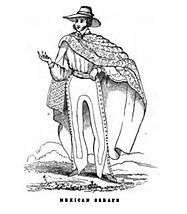Serape
The sarape or jorongo is a long blanket-like shawl, often brightly colored and fringed at the ends, worn in Mexico, especially by men. The spelling of the word sarape [1] (or infrequently, zarape[2]) is the accepted form in Mexico and in other Spanish-speaking countries. The term sarape is for the rectangular woven blanket (no openings), though in more recent years it can also be used to refer to a very soft rectangular blanket with an opening in the middle for one's head, similar to a poncho called gabán, or jorongo in Mexico. Modern variations of some serapes are made with matching hoods for head covering. The length varies, but front and back normally reach knee height on an average person.
.jpg)
Available in various colors and design patterns, the typical colors of serapes from the highland regions are two-tone combinations of black, grey, brown, or tan depending on the natural color of the sheep flocks grown in the area, with large design patterns utilizing traditional indigenous motifs. On the other hand, the traditional serape as made in the Mexican state of Coahuila in north-eastern Mexico near the city of Saltillo often consists of a dark base color with bands of yellow, orange, red, blue, green, purple or other bright colors. The ends are usually fringed.
History
The sarape is thought to have its forebears in garments worn in the region near Chiautempan and Contla, Tlaxcala. During the Colonial period, it was taken to northern New Spain where it was adapted to the climate and the motifs changed. The city of Saltillo is strongly linked to the development of the sarape, although it was widespread throughout the area then known as Nueva Vizcaya.
Guatemalan serape
The serape is not a typical garment for the Maya highland people, who wear different clothing in cold regions. The serape is more of an imitation of the Mexican serape with a Maya twist, and their production is specifically for sales to foreigners or city dwellers who feel attracted to the garment. The sale of sarapes goes through a broker process, where the Maya families, who depend mostly upon agricultural work, manufacture small quantities for additional income. The brokers display the sarapes at a higher price on local markets or the sides of highland roads in improvised huts. The brokers are typically Maya. The appeal of the sarape may consist in the fact that these are woven by Maya families, normally women, in their traditional house looms, giving the sarape a "handmade" look.
See also
References
Notes
- Real Academia Española
- "zarape | Definición de zarape en español de Oxford Dictionaries". Oxford Dictionaries | Español. Retrieved 2019-05-01.
Bibliography
- Conkling, Alfred Ronald (2009). Appleton's Guide to Mexico. Richardson. ISBN 1-115-58237-2.
- "sarape". Diccionario de la Lengua Española (22nd ed.). Real Academia Española. Retrieved 26 May 2011.

